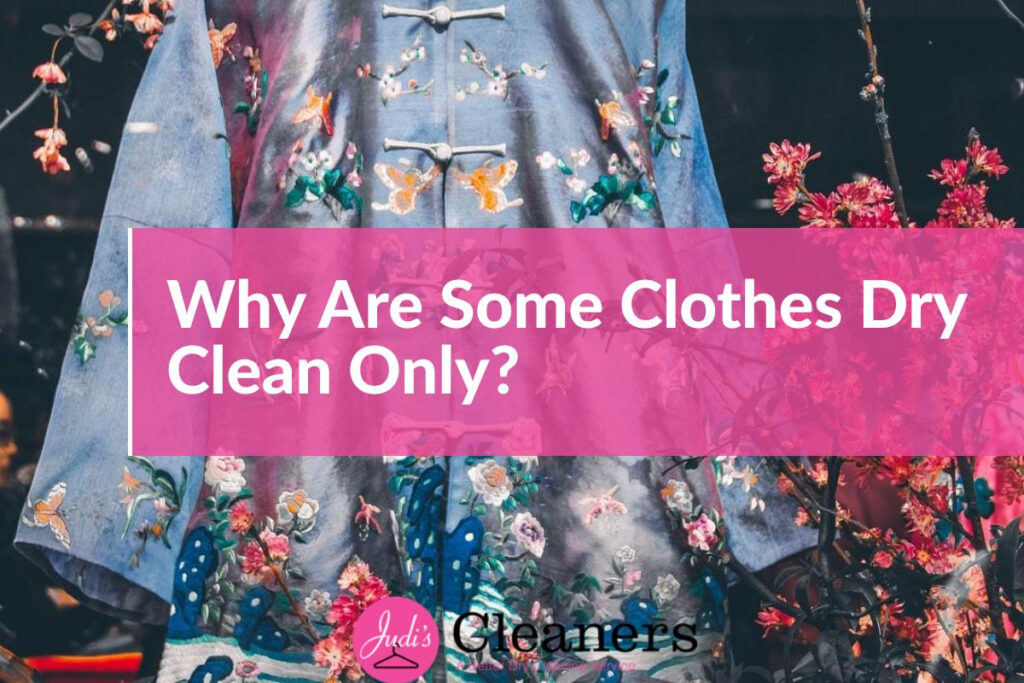Washing clothing isn’t difficult, but there is a learning curve to doing it proficiently. Everyone has their tips and tricks for separating clothes and getting stubborn stains out, but the most fundamental lesson is reading a clothes tag.
The tag provides valuable information about how you should wash a particular piece of clothing. The instructions are simple but require some interpretation if you’re a beginner.
However, one cleaning directive even stumps people who are fluent in clothing tag instructions: “dry clean only.” Why does it say why are some clothes dry clean only on the tag? When apparel requires dry cleaning, most people either don’t know what that actually means or dread a more complicated process.
Fortunately, that doesn’t have to be you. Below we’ve provided all the information you need to figure out why some clothes are dry clean only and what you need to do to get these clothes clean.
What Is Dry Clean Only, and Who Created It?
The first step to washing dry clean only clothes is, of course, knowing what the term means. Dry cleaning is a method of cleaning clothes with a liquid solvent instead of water (hence the “dry” in the name). The tailor Thomas L. Jennings patented a method of “dry scouring” in 1821.
There’s also the method pioneered by French dye-worker Jean Baptiste Jolly, who’d use kerosene or gasoline as a solvent to remove stains. While this method is more widely known, the use of highly flammable substances made it far more unsafe during the period, resulting in numerous dry cleaner shop explosions.
After World War I, a new, safer solvent called tetrachloroethylene was introduced into the process. This made dry cleaning more stable and pushed the process closer to modern-day practices.
Related:
How Are Clothes Washed “Dry Clean Only”?
As mentioned previously, “dry” cleaning isn’t an entirely accurate name because of the liquid solvents used during the process. Dry cleaning isn’t too dissimilar to laundry with a washer and dryer; it simply takes more skilled labor because of the harsh chemicals used to clean the clothes. For this reason, the entire procedure is limited to dry cleaning services.
You can break down dry cleaning into five crucial steps:
- Tagging: Dry cleaners usually handle several different orders along with yours, so proper identification is key to ensuring nothing is misplaced. After dropping off your clothes, the attendant will place a colored tag on the apparel that says when it was dropped off, who it belongs to, and what kind of attention it needs.
- Pre-treatment: The attendant will treat stains before putting them through dry cleaning. The chemicals they use for this step depend on what kind of stains have accumulated on your clothes. It’s essential to inform the attendant of what’s been spilled on your apparel to ensure the next step is as effective as possible.
- Dry cleaning: A dry cleaning machine works pretty similarly to the typical washer and dryer (save for the fact that most modern dry-cleaning appliances are combined washer-dryer units). These machines can hold from 20-100 pounds of clothing at a time in a perforated basket that allows solvent to flow inside, soaking the garments and flowing out, taking the stains with it.
After the cycle is done, the internal chamber spins rapidly to completely draw the solvent out of your clothes before circulating warm air to dry them.
- Spot cleaning: The cleaner then closely examines each piece of clothing to ensure that all stains have been removed. If any stubborn spots remain, they use steamers, hoses, vacuums, and more targeted chemicals to eliminate them.
- Finishing: Lastly, finishing touches are made to your clothes to ensure that they look their best. This generally involves the generous use of steam, ironing, and creasing.
Dry cleaning costs depend on the type of garment you’re dropping off at the cleaners. On average, prices can start at as little as $10 for simple clothing to as much as $500 for elaborate attire, like wedding dresses or suits.
Related: How Long Does Dry Cleaning Take?
What Happens if You Wash Dry Clean Only Clothes?
Whether or not your clothing is dry clean only depends on the material from which it’s made. Some fabrics are simply too delicate to go through a normal washer and dryer cycle without shrinking or becoming severely damaged. The most at-risk materials are:
● Linen: Water causes the material’s flax fibers to warp, and heat can quickly leave scorch marks.
● Wool: This material will change at the molecular level when exposed to water for an extended period. Wool clothing is infamous for dramatically shrinking because of this property.
● Rayon: A semi-synthetic fiber, this fabric is made from cellulose that doesn’t retain dyes well when exposed to water. Putting clothing made of rayon into the washing machine is an excellent way to ruin a whole load of clothing at once.
● Silk: Silk has a similar problem to rayon, where putting it in water causes colors to bleed off. However, this is because its natural durability makes it so dyes cannot fully diffuse into the fabric.
Despite the risk of damage, some clothes handle alternative cleaning methods reasonably well. Dry clean only labeling makes most consumers think that the garment is high quality, so it’s not uncommon for clothing manufacturers to attach that label for increased profits. While using a washer and dryer may still cause damage, hand washing tends to work as an alternative if you don’t want to pay a dry-cleaning bill.
Hand Washing Dry Clean Only Clothing
Hand washing your clothing is often an effective alternative to dry cleaning because you have greater control over the amount of pressure and force you’re applying to them. In addition, it’s a far less aggressive laundering method than putting them through a washer and dryer, so the risk of damage is reduced. Additionally, if wear does start to occur, you’ll notice quicker and have an opportunity to mitigate it.
However, reduced risk of damage doesn’t mean no risk of damage. Dry clean only fabric is delicate and can still easily fall apart or bleed, even if you’re washing it directly. To minimize the chances of ruining your favorite shirt, you can apply a small amount of detergent and water to an inconspicuous area and see how the material reacts. If there’s slight shrinkage or running colors, then it’s best to explore other cleaning methods.
More Alternative Cleaning Methods for Dry Clean Only Clothes
If dry cleaning and handwashing aren’t options for your attire, there are several other cleaning methods for you to consider. For example, a recent innovation in dry cleaning technology is a home kit that allows consumers to simulate the dry-cleaning process by putting their clothes in their home dryers.
The kit consists of pre-treatment chemicals, solvent-soaked sheets, and a cloth bag. The process is similar to the full dry-cleaning procedure: You treat the stained areas with the pre-treatment chemicals to make them easier to pick up, then place your clothes into the bag with a solvent sheet, and finally, let the dryer run for the amount of time listed on the packaging.
The heat causes the solvent to agitate and dissolve, removing any stains on the clothing.
Another thing to keep in mind is that some garments will “set” after one or two dry cleaning cycles. While you’ll still need to have them cleaned, it’s possible for the dry-cleaning process to weather the material enough to handle a normal washer and dryer cycle. Just be sure to wash them on the delicate setting as the harsher cycles still risk harming them.
Professional Dry-Cleaning Service
If you asked “why are some clothes dry clean only” at the beginning of the article, then you should have a decent answer now. But, to reiterate, some clothes are dry clean only because they’re made from materials that don’t handle water well. Putting them through a standard washer and dryer cycle runs the risk of damaging them and potentially ruining your other clothes in the process.
While handwashing and at-home dry cleaning kits are acceptable alternatives to typical dry cleaning, a full dry-cleaning service guarantees the most thorough wash for your more delicate attire. Additionally, a professional cleaner will ensure that your clothing looks just as good as the day you got it.
Here at Judi’s Cleaners, we provide top-quality dry-cleaning service with the added convenience of fast pick-up and delivery of your clothes. You won’t even have to leave your house with our online ordering system. Just place your order, put your clothes in a bag, place them at the designated pick-up spot, and one of our vans will promptly come around to take them to our main cleaning facility.
Once your expert dry cleaning is finished, we’ll drop off your clothes in one of our sanitized VIP bags to ensure your clothes remain clean and crisp on the ride over.
If you’re in the Greater Sacramento area and need professional dry cleaning, give Judi’s Cleaners a call and schedule your pick up today!

